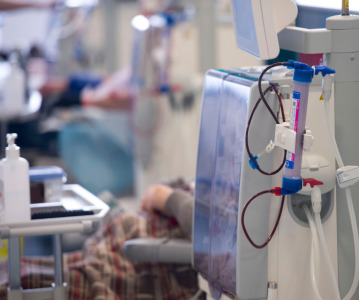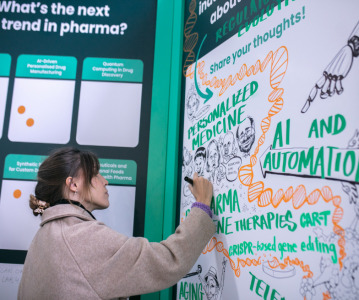Technology and managing risk within the high potency drug sector

Manufacturing high potency drugs - the challenges and innovations to mitigate the risks.
The huge global demand within potent drug production - whether this be in the development of antibody drug conjugates (ADCs) or in the need for conventional drug manufacturing - is encouraging requests for high potency handling and, therefore, a need for high-containment facilities. Michael Avraam, global product manager at ChargePoint Technology for the PharmaSafe range of products, talks to CPHI Online about the risks, challenges and innovation in today's high potency drug sector.
How is demand for high potency manufacturing affecting the industry?
The increasing demand for the capability to handle high potency drugs is having a significant impact on the sector. Many existing manufacturing facilities, unfortunately, do not have these facilities and therefore companies are needing to upgrade, develop, and sometimes even construct new facilities to meet customer needs. These facilities have also had to be designed to be easily adaptable for the variation in production that high potency drugs can bring. This rising demand has also placed an importance on selecting the right outsourcing partners to offer these specialist capabilities, which is shaping the contract manufacturing landscape. If a prospective partner can demonstrate the ability to be flexible in the containment solutions they offer, particularly in their capacity to scale up production and be proactive, they will be more successful.
Where do the challenges lie in the manufacture of high potency drugs?
The most significant challenge will always lie in the handling of these ingredients across the supply chain. Not only regarding which equipment is needed to ensure product protection and avoidance of cross-contamination, but also in the importance of operator and environmental safety. Employees and their environment need to be shielded from exposure to these drugs and their safety rests on the manufacturer’s ability to select the correct containment solution to suit the process. How this solution is selected, installed and set-up is of vital importance as it will impact the overall safety. Appropriate and ongoing training is therefore essential, as well as the continuous monitoring of operations to guarantee maximum protection and that safety is always put first. Due to the complex nature of high potency drugs, finding a balance between ensuring safety whilst maintaining productivity and operability can present another challenge. This often requires upgrading or investing in new equipment which can be particularly challenging for smaller manufacturers.
In what other ways can risk be controlled when using high potency ingredients?
Technology plays a big role in minimising the risks associated with potent compounds. Some examples include rigid and flexible barrier isolators, which offer good levels of containment security. Extracted booth technology can also assist in handling larger operations as it can give a secondary level of containment protection. New design technologies also assist in removing the risk of airborne exposure, and have been the key to achieving high containment in recent years. Split butterfly valves (SBVs) have evolved over the last 25 years with the rise in high potency manufacturing and have presented a novel and versatile approach that can be easily integrated across containment solutions. The use of closed containment systems such as this minimise risk, without damaging productivity.
How is technology continuing to shape the high potency industry?
Ultimately, advancements in technology have driven the changes we are witnessing in manufacturing facilities, and they will continue to do so in the future. Technology aimed at reducing risk will continue to be the number one priority. The future presents opportunities such as using robotics to remove all physical human interaction with harmful substances. Industry 4.0 has already begun to take hold in the automation of systems across the board.

Related News
-
News Cassava Sciences halts Alzheimer's drug trial after limited progress
Cassava Sciences have drawn a close to their investigations and development of the drug simufilam, which they intended to be used for the treatment of Alzheimer’s disease. -
News US FDA adds haemodialysis bloodlines to devices shortage list
On March 14, 2025, the US FDA published an open letter to healthcare providers citing continuing supply disruptions of haemodialysis bloodlines, an essential component of dialysis machines. -
News Vertex Pharmaceuticals stock jumps as FDA approves non-opioid painkiller
UK-based Vertex Pharmaceuticals saw their stock shares soar as the US FDA signed off on the non-opioid painkiller Journavx, also known as suzetrigine, for patients with moderate to severe acute pain, caused by surgery, accidents, or injuries. -
News Lessons from CPHI Milan 2024: Sunny Intervals for Pharma Manufacturing?
As the 2024 CPHI conference wrapped up in Milan, we caught up with L.E.K. Consulting – a global strategy consulting firm with deep expertise in pharma manufacturing – to discuss evolving market perspectives and business outlook. -
News US BIOSECURE Act passed by US House of Representatives
The controversial act, which has already impacted several foreign companies operating in the US, was passed by the House of Representatives on September 9, 2024. It is now headed for the US Senate before it can be signed into law by President Joe Biden... -
News Pharmaceutical Supply Chain People Moves
The latest appointments, promotions, and structural changes across the pharmaceutical supply chain. -
News Drug prices agreed upon as part of the US Inflation Reduction Act
The Inflation Reduction Act brought into constitution by the Biden administation in 2022, which proposed a drug price negotiation between the government and pharmaceutical companies, has reached it's first agreement. -
News BIOSECURE Act continues to loom over Chinese pharma manufacturers
With the US BIOSECURE Act on its way to passing into legislation, Chinese companies are facing declining revenues within the first half of 2024 as US pharmaceutical and healthcare companies pull their businesses from the country.
Recently Visited
Position your company at the heart of the global Pharma industry with a CPHI Online membership
-
Your products and solutions visible to thousands of visitors within the largest Pharma marketplace
-
Generate high-quality, engaged leads for your business, all year round
-
Promote your business as the industry’s thought-leader by hosting your reports, brochures and videos within your profile
-
Your company’s profile boosted at all participating CPHI events
-
An easy-to-use platform with a detailed dashboard showing your leads and performance







.png)